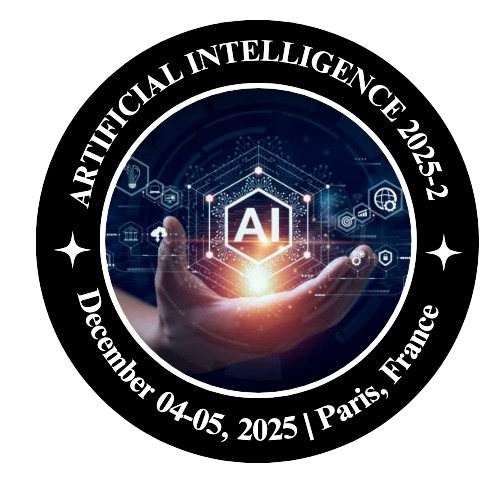About Conference
Join us for the 6th International Congress on AI and Machine Learning in Paris, France, on December 04-05, 2025. This year’s theme, “Unlocking the Future: Transformative Power of AI and Machine Learning in Data Science” highlights groundbreaking advancements and transformative applications in the field.
Artificial Intelligence 2025 serves as a global platform to explore the latest technologies, innovations, applications, and cutting-edge research, fostering the exchange of knowledge among international experts. The conference brings together renowned professors, specialists, research scholars, student delegates, and exhibitors from around the world.
The event will feature oral presentations, poster sessions, keynote addresses, workshops, and much more, offering a dynamic and engaging environment for learning, networking, and collaboration.
Discover opportunities to connect with leading AI pioneers, share your research, and explore innovative solutions shaping the future. Engage with cutting-edge exhibits and workshops that showcase the latest advancements in AI and Machine Learning. Gain insights from distinguished speakers and participate in discussions that drive the field forward.
Sessions and Tracks
Track 01: Artificial Intelligence
Artificial Intelligence (AI) involves creating systems capable of performing tasks that require human intelligence, such as reasoning, learning, and decision-making. It encompasses a broad range of technologies and methods, including machine learning, computer vision, and natural language processing. AI aims to automate complex processes and improve efficiency in industries like healthcare, finance, and transportation. The development of AI technologies is driving innovation and reshaping how we interact with machines. Its ethical implications and governance are crucial areas of research.
Track 02: Machine Learning
Machine Learning (ML) is a subset of AI that focuses on developing algorithms enabling systems to learn and improve from experience without explicit programming. It is categorized into supervised, unsupervised, and reinforcement learning, each addressing specific types of problems. ML powers applications like recommendation systems, fraud detection, and autonomous vehicles. Its success relies on high-quality data and advanced computational techniques. The integration of ML into industries is transforming how businesses operate and make decisions.
Track 03: Deep Learning
Deep Learning is a specialized area of ML that uses neural networks with multiple layers to process and analyze complex data. It excels in tasks like image recognition, natural language processing, and autonomous driving. By mimicking the human brain's structure, deep learning models extract meaningful patterns from large datasets. Its applications span various fields, from medical imaging to creative arts. Advances in computing power and algorithms continue to drive deep learning's growth.
Track 04: AI in Cybersecurity
AI in Cybersecurity leverages machine learning and data analytics to detect, prevent, and respond to cyber threats. AI-powered tools can identify unusual patterns and predict potential vulnerabilities, providing proactive defense mechanisms. Applications include threat intelligence, user behavior analysis, and automated incident response. AI enhances security across industries, protecting sensitive data and critical systems. Its adaptability makes it indispensable in combating the evolving landscape of cyberattacks.
Track 05: Predictive Analytics
Predictive Analytics uses statistical techniques and machine learning to analyze current and historical data to forecast future trends. It aids decision-making in areas like supply chain management, customer behavior analysis, and risk assessment. Businesses use predictive models to optimize operations and improve outcomes. By identifying patterns and relationships, it enables organizations to stay competitive and responsive. The technology's effectiveness grows with the availability of quality data and advanced analytics tools.
Track 06: Natural Language Processing
NLP focuses on enabling machines to understand, interpret, and generate human language. Applications include chatbots, voice assistants, and sentiment analysis. It bridges the gap between human communication and machine understanding. NLP combines linguistics with computational algorithms to process unstructured text and speech data. Recent advancements in NLP have led to the development of powerful models like GPT, revolutionizing text-based interactions.
Track 07: Robotics and Automation
Robotics and Automation involve designing intelligent machines to perform tasks with minimal human intervention. These technologies enhance productivity, reduce operational costs, and ensure precision in manufacturing, healthcare, and logistics. AI-driven robots adapt to their environment and learn from experience, enabling complex problem-solving. Advances in robotics are leading to innovations like collaborative robots (cobots) and autonomous drones. The synergy of AI and robotics continues to push the boundaries of automation.
Track 08: Neural Network Optimization
Neural Network Optimization focuses on improving the performance and efficiency of neural network models. Techniques include hyperparameter tuning, model pruning, and architecture search. Optimization ensures models achieve high accuracy while minimizing computational resources. It is crucial for deploying AI systems in resource-constrained environments like mobile devices. Advances in this area contribute to the scalability and accessibility of deep learning technologies.
Track 09: Reinforcement Learning Applications
Reinforcement Learning (RL) trains models to make decisions by rewarding desirable actions and penalizing undesired ones. It is widely used in robotics, game development, and autonomous systems. RL algorithms excel in environments where the best course of action is not immediately obvious. Applications include optimizing supply chain operations and creating adaptive learning systems. RL's iterative approach enables systems to continuously improve performance over time.
Track 10: Internet of Things
The Internet of Things (IoT) connects physical devices to the internet, enabling them to collect and exchange data. AI and ML enhance IoT systems by enabling real-time data analysis and intelligent decision-making. Applications range from smart homes and cities to industrial automation and healthcare monitoring. IoT fosters seamless integration between digital and physical worlds. The combination of IoT and AI is driving innovations in connectivity and automation.
Track 11: Computer Vision
Computer Vision enables machines to interpret and process visual information from the world. It uses AI algorithms to analyze images and videos, enabling tasks like facial recognition, object detection, and scene understanding. Applications span industries such as healthcare (medical imaging), automotive (autonomous driving), and retail (visual search). Advances in deep learning have significantly enhanced the capabilities of computer vision systems. Its potential continues to grow with the proliferation of imaging data.
Track 12: Artificial Neural Network
Artificial Neural Networks (ANNs) are computational models inspired by the human brain's structure and functioning. They consist of interconnected layers of nodes (neurons) that process information. ANNs are at the core of deep learning, enabling applications like speech recognition, fraud detection, and image classification. They learn by adjusting weights during training to minimize errors. Ongoing research focuses on improving their scalability and interpretability.
Track 13: Multiagent Systems
Multiagent Systems involve multiple autonomous agents interacting and collaborating to solve complex problems. Applications include traffic management, distributed robotics, and energy optimization. These systems use AI techniques to enable coordination and decision-making among agents. They are particularly useful in environments requiring decentralized solutions. Multiagent systems exemplify the power of collaboration in solving dynamic challenges.
Track 14: Cloud Computing
Cloud Computing provides scalable and flexible computational resources for AI and ML applications. It enables researchers and developers to access powerful infrastructure without investing in hardware. Cloud platforms support large-scale data storage, model training, and deployment. Services like AI as a Service (AIaaS) simplify the integration of AI into businesses. The combination of AI and cloud computing drives innovation across various domains.
Track 15: Big Data
Big Data refers to the massive volume of structured and unstructured data generated daily. AI and ML algorithms analyze this data to uncover patterns, trends, and insights. Big Data fuels applications like recommendation systems, fraud detection, and market analysis. Its effective use requires robust data processing pipelines and storage solutions. Big Data analytics is transforming industries by enabling data-driven decision-making.
Track 16: Future Scope of AI
The future scope of AI includes advancements in autonomous systems, personalized medicine, and quantum computing. AI is expected to revolutionize industries by improving efficiency and creating innovative solutions. Emerging trends focus on ethical AI, sustainable development, and human-AI collaboration. As AI continues to evolve, it promises to address global challenges and enhance quality of life. Its integration into daily life will shape the future of technology.
Track 17: Ethical AI Development
Ethical AI Development focuses on creating systems that are transparent, fair, and accountable. It addresses challenges like bias, privacy, and the societal impact of AI technologies. Ethical guidelines ensure responsible use and deployment of AI in sensitive areas like healthcare and law enforcement. Organizations are increasingly adopting frameworks to align AI development with human values. Research in this area is critical for building trust in AI systems.
Track 18: Generative Adversarial Networks
GANs are a class of ML models where two networks (a generator and a discriminator) compete to improve performance. They are widely used for generating realistic images, videos, and text. Applications include deepfake creation, data augmentation, and art generation. GANs have transformed creative industries and enabled advancements in simulation technologies. Research focuses on improving their stability and scalability.
Track 19: Applications of Machine Learning
Machine Learning applications span diverse fields, including healthcare, finance, retail, and transportation. Examples include predictive maintenance, personalized recommendations, and fraud detection. ML drives efficiency and innovation by automating complex processes and uncovering hidden patterns in data. The adaptability of ML algorithms ensures their relevance across industries. Continuous advancements in ML expand its applicability and impact.
Market Analysis
Global Market Insights
ARTIFICIAL INTELLIGENCE-2025, the global market is expected to witness significant growth, driven by the increasing adoption of AI technologies across industries, heightened interest in machine learning research, and the rising need for knowledge-sharing platforms. With the global AI and ML market projected to reach USD 225.91 billion by 2030 at a CAGR of 36.2%, conferences in this field will play a pivotal role in fostering collaboration, disseminating cutting-edge research, and advancing innovation.
Market Size and Growth
The AI and Machine Learning conference segment is forecasted to grow in parallel with the AI industry, with an estimated market size of USD 2.8 billion by 2025. This growth reflects the demand for professional gatherings where researchers, industry leaders, and innovators can exchange ideas and insights. With a projected annual growth rate (CAGR) of 25-30% between 2023 and 2025, the conference market's expansion aligns with the increasing reliance on AI-driven solutions across sectors.
By 2025, the number of AI and ML conferences globally is expected to exceed 2,000 annual events, reflecting the growing interest and investment in these technologies. Regions like Asia-Pacific and the Middle East are emerging as key hubs for AI events due to increasing government initiatives and private sector investments in tech infrastructure. The hybrid conference model is anticipated to dominate, combining in-person and virtual formats to maximize global participation. Corporate sponsorships and collaborations with academic institutions are expected to further boost the scale and visibility of these events. Additionally, the focus on niche areas such as generative AI, ethical AI, and AI for social good will drive the diversification of conference themes and attract a broader audience.

Benefits of Participation
Benefits of Participation- Speaker
-
Worldwide acknowledgment of Researcher’s profile
-
Make Lasting connections at Networking and Social Events
-
An opportunity to give One-page advertisement in abstract book and flyers distribution which eventually gets 1 Million views and add great value to your research profile
-
Learn beyond your field of interest, a change to know more about the new topics and research apart from your core subject from ARTIFICIAL INTELLIGENCE.
-
We provide unique convergence of Networking, Learning and Fun into a single package
Benefits of Participation- Delegate
-
Professional Development –Uplift the knowledge and skills
-
Conference attendance inspires, rejuvenates, and energizes delegates
-
Your participation at our conference will be helpful for a new approach and ideology that can be utilized for the extending the outcome of companies or industries.
-
Opportunities to meet through online webinar for ARTIFICIAL INTELLIGENCE researchers and experts of same field and share new ideas
Benefit of Participation- Sponsor
-
Exposure to the international atmosphere will increase the odds of getting new business
-
Opportunity to showcase the new technology, new products of your company, or the service your industry to a broad international participant.
-
World’s No. 1 platform to show case ARTIFICIAL INTELLIGENCE products.
-
Increase business by lead generation through our conference participants.
-
ARTIFICIAL INTELLIGENCE conferences create opportunities for greater focus and reflection that could help you take your business to the next level.
-
Benchmarking key strategies for business and moving it forward
-
Real Benefits in New business-Many Organizations make deals and sign contracts at our ARTIFICIAL INTELLIGENCE.
Benefit of Association for Collaborators
-
No one in the world have this huge visitor towards ARTIFICIAL INTELLIGENCE, this is the best platform to showcase the society
-
Create long-lasting relationships with the peers
-
Promotional content and Logo of your Association at our conference banner, website and other proceedings, branding and marketing material will increase your subscribers/Members number by 40%.
-
Our event visibility to your Organization page can give a great impact for your association in the Global Market forum.
-
Your representatives can network with key conference delegates to update their knowledge and understanding of your organization and services.
-
Details will be incorporated with ARTIFICIAL INTELLIGENCE promotional materials like flyers, brochure, pamphlets, program which will be distributed to Hospitals, Universities, Society and Researchers.
Visa Trip Advisor
Planning a trip to Paris, Frace? Attend our Meeting!
Issue with VISA?
To support participants in their Visa Application Process, we provide VISA support documents as follows:
1. Official Letter of Invitation
2. Official Letter of Abstract Acceptance
3. Receipt of Payment
Points to note:
-
Visa Letter (official letter of invitation) will be issued only after successful registration and payment for the conference.
-
Visa Letters can be issued only for the individual accepted to attend the conference.
-
Please contact the Program Manager – Alice Mary ,via machinelearning@memeetings.com to arrange for a Visa Letter.
Kindly provide us with the following information for Visa Letters:
-
Your name as it appears on your passport
-
Passport Scan Copy (passport number and date of birth)
-
Abstract Acceptance letter
Payment Methods:
1. Payment Gateway - RAZORPAY
2. Bank-to-Bank transfer
Having trouble with registration?
Please contact Program Manager – Alice Mary via machinelearning@memeetings.com. The ARTIFICIAL INTELLIGENCE-2025, team will provide you with an INVOICE for the requested price, enabling you to make the Bank-to-Bank transfer.
Past Conference Report
ARTIFICIAL INTELLIGENCE-2025
The 6th International Congress on AI and Machine Learning was successfully held as a webinar on July 21, 2025. Centered around the theme, "Revolutionizing Data Insights with AI and Machine Learning," the congress provided a dynamic platform for exploring the transformative potential of AI and ML technologies. The event featured engaging discussions, insightful presentations, and valuable networking opportunities with experts and enthusiasts from around the world.
Artificial Intelligence 2025 served as an international forum for sharing the latest advancements, innovations, applications, and research in AI and machine learning. The congress brought together prominent global experts, professors, specialists, research scholars, student delegates, and exhibitors, offering a diverse and enriching experience.
Conference highlights included impactful oral and poster presentations, keynote speeches, interactive workshops, and exclusive panel discussions with industry leaders. Attendees also witnessed live demonstrations showcasing real-world AI applications. The event fostered meaningful learning, collaboration, and progress—making a significant contribution to the ongoing evolution of AI and ML.
Past Reports Gallery



















